Teresa Pilgrim, University of Surrey
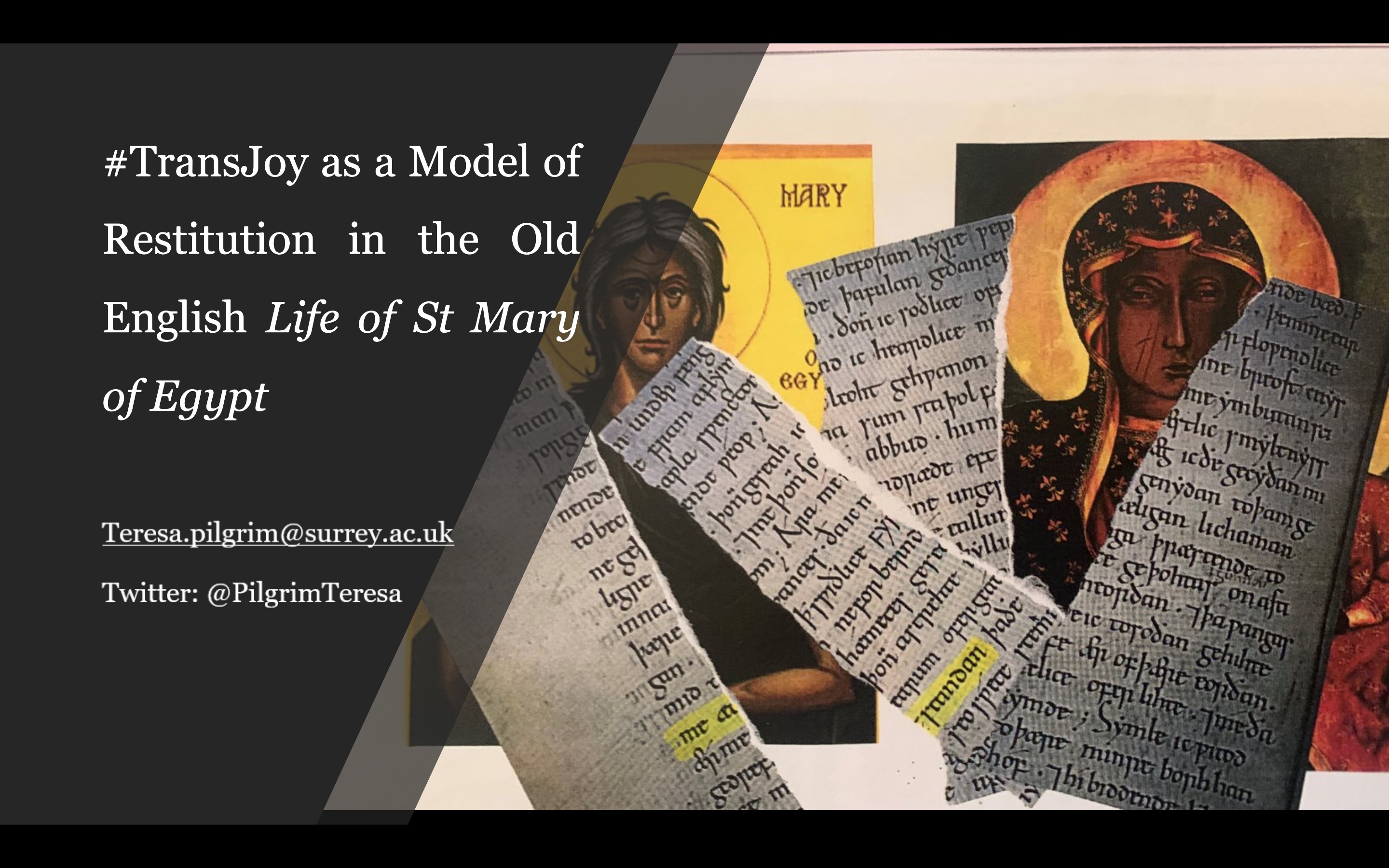
C/W: In this paper I discuss sexual violence and conversion therapy in the shared yet distinct contexts of Black Lives and Trans Bodies. Ethically, I cannot speak for Black trauma. Therefore, I speak for trauma born of the violent suppression of gender queer identity and queerness. Due to the religious nature of violence in my discussion some may find it offensive.
This paper argues that the presence of #TransJoy in the Old English Life of St Mary of Egypt provides a model of restitution for decolonial and queer ecology. The term #TransJoy is used as a hashtag across social media to share affirmations of Trans experience and/or Trans Lives. What constitutes #TransJoy varies between individual experience, but the sentiment is always about Trans positivity and often relates to gender euphoria experienced by those expressing it.
My paper arises from the concluding chapter of my thesis in which I examine the influence and impact of gender-based violence on textual and cultural embodiments of identity in gender queer women, specifically female masculinities which I argue as a trans perspective.

This trans embodied perspective arises in the context of what I term radical ecofeminism which is a constantly evolving conceptual yet also, embodied process that collectively centres intersectionality, and queer and trans perspectives in order to create both transformative and restitutive literary space.
In writing this paper, I faced a dilemma which after repeatedly failing to conclude my paper I realised was because I was working on two separate documents. One that held information I thought my post should look and sound like and the other, which contained what I actually wanted to say. To overcome this dilemma, I returned to the words of Audre Lorde in whose paper: The Transformation of Silence into Language and Action was delivered [in 1977 at the Modern Language Association’s ‘Lesbian and Literature panel’], despite Lorde’s initial fears which she discusses in both the process of writing and delivering her paper. When I first read the Life, Lorde’s words powerfully resonated with my [radical ecofeminist] analyses of it and the pernicious silence, I argue it enforces on its readers in an additional preface and confessions staged to convert Mary of her queerness. In a rhetorical question Lorde asks herself:
What are the words you do not yet have? What do you need to say? What are the tyrannies you swallow day by day and attempt to make your own, until you sicken and die of them, still in silence?[1]
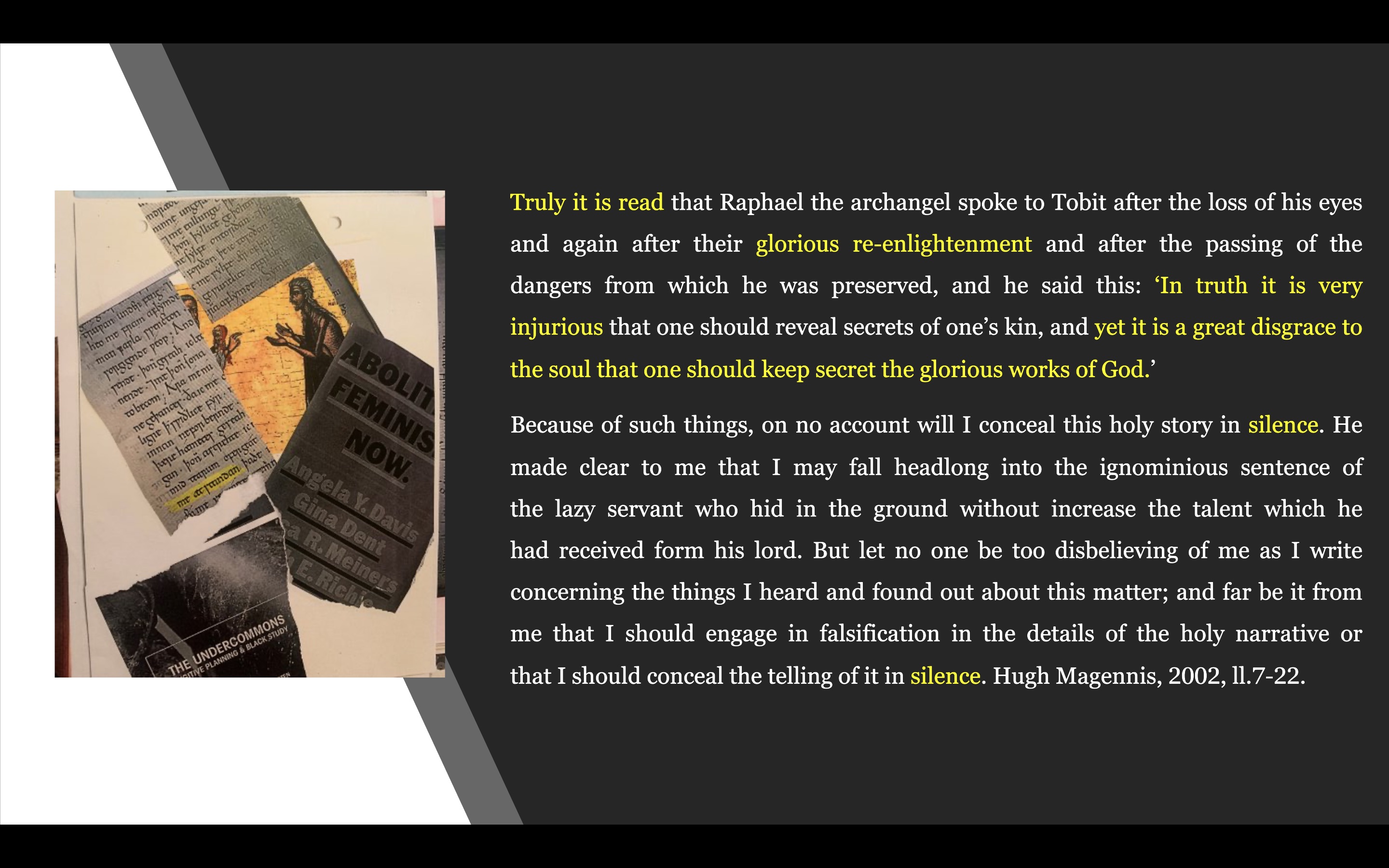
The anonymous male authorial adaptations made to the Life which is found in but not attributed to Ælfric in the Lives of Saints, by addition of its preface, offers a meditation on silence and truth. The author makes clear that to have the wisdom to know whether to choose silence or speak the truth his audience only need listen to the true word of God in Christ, who, manifest in the New Covenant is written in their hearts and minds which is where metaphorically the author situates Mary’s battle to save her soul. Thus, in the Life, the author and translator does not silence Mary of Egypt, rather, he forces her to speak by invasive hostile narration of confessions to repent, convert, and save her soul.
In answer to the rhetorical question Lorde poses in her paper, she writes:
In the cause of silence, each of us draws the face of her own fear – fear of contempt, of censure, or some judgement, or recognition, of challenge, of annihilation. But most of all, I think, we fear the visibility without which we cannot truly live.[2]
This paper is born out of fear. Not a natural fear but one I argue is created deliberately in each of us and (based upon our perception of binary gender) which is made visible in the Life by authorial introspection subsequently narrated and embodied by the figure of Mary of Egypt: that of masculinity. However, by authorial failure to recognize his own introspection the author reveals how masculinist authority is generated and maintained by fear he projects onto Mary, that of gender queer masculinity. Social pressure enforced by the gender binary creates a need for external collective validation based upon the threat and fear of exclusion which, I argue simultaneously divides us from within the psyche to empower and disempower people by the hierarchy of masculine authority over feminine. This is why some people, such as the author, assume authority based upon their perceived right to masculinity while others are taught to fear masculinity, primarily in men but also women, and for some, this includes fear of our selves. The author harnesses this fear of judgement which he conflates with acceptance of the New Covenant.
In the two earliest Greek original versions from which the Life was first translated into Latin and then Old English, Mary is described as a holy woman both, as ‘cantor of the holy church of the Resurrection of Christ’ and then also, as ‘a nun [<monastria>] who was very devout.’[3] The sole motivation in both versions for Mary’s desert exile is to escape sexual violence from men in whose minds the devil had sown desire for Mary out of jealousy of her virgin state, but as a result, Mary is held responsible for saving them from their sexual sins. In contrast, the Life transforms Mary into a prostitute from the Hebrew term, harlot (and a rapist) to demonstrate the depth of her depravity, both as a Black female masculine queer saint and by her extreme bodily penitence in the desert, specifically sexual abstinence outside of cis-heteronormative marriage which are used to illustrate their greater potential to obtain God’s grace by her spiritual conversion which I argue, additionally, constitutes conversion therapy.
The significance of the early Greek descriptions of Mary in this later context also delineate between early eremitic and later cenobitic expressions of monasticism which highlight Mary’s central role as cantor leading the sung liturgy and a subsequent shift to silenced prayer in the Life in which she now also requires an intermediary confessor to validate her words:
And speaking thus, she … with eyes raised high and outstretched arms, began to pray, moving her lips in silence, so that no voice could be heard there that one could perceive. Thus Zosimus could make out nothing of the prayer, ll. 320-324.
The inaudibility of Mary’s words in silent prayer shifts almost immediately to enable her to verbally acknowledge and confess her sinful nature as a woman:
Why, abbot, do you vex your thoughts to take offence with me, as though I were some spirit engaging in prayer deceitfully? But know, sir, that I am a sinful woman, although protected from without by holy baptism, and I am no spirit but dust and ashes and wholly flesh, and nothing spirit-like …’, ll. 340-345.
Mary’s depiction in the Old English version sets her within a model of redemption by the life cycle of Christ which Mary emulates throughout the Life and culminates with the holy sacraments of the Eucharist being administered to her by Zosimus. Subsequently, Mary is emplaced in the desert as both a symbolic space where God speaks to man and where, in Christ’s wanderings he battles with the devil.
Mary is depicted alone in two significant locations. First, outside the Church of the Holy Sepulchre door which is held fast by divine intervention and where [quote] ‘I was immediately pushed away from all the people, until I alone stood in the courtyard [unquote], (ll. 465-466). Mary is also depicted alone in the desert for forty-seven years of which she later confesses to Zosimus:
‘I had an excessive desire for lewd songs [that] troubled me, when they brought it into my mind to sing the devil’s songs which I learned formerly in the world (ll. 626-629).
This confession is followed in contrast, by Mary’s lamentation and intense focus upon the image depicted in her mind ‘of the holy mother of God, who had previously received me in covenant with her’ (ll. 633-635). Covenant or ‘truwan’ in Old English comes from the masculine noun truwa which in Bosworth-Toller’s Online Dictionary is exemplified by quotes from Genesis or in homilies which refer to the establishment or dissolution of nations through their covenants with God. It is also noteworthy that the concerns of psalm forty-seven the same period of Mary’s exile are that of God’s establishment of the church.
There are two further notable points at which the author conflates the gender binary with the establishment or fall of nations in the desert which he subsequently consolidates in the masculinist body of the church. The first describes Mary’s mind as her inner desert to which she hastens after speaking with Zosimus. Mary requests a prayer of John the abbot of the monastery to which Zosimus is about to return across the desert (ll. 749-750). This situated example of male, masculine authority offers a clear chain of command typical of later cenobitic monasticism which is staged in the desert (and monastery) to establish binary gendered orthodoxy as Christian doctrine in each environment.[4] The Oxford English Online Dictionary[5] states the term orthodoxy comes from the Greek and refers to
The quality or character of being orthodox; belief in or agreement with doctrines, opinions, or practices currently held to be right or correct, esp. in religious matters.
The second point concerns how, each time Zosimus encounters Mary in the desert he is subsequently described in ways which, as Diane Watt and Clare Lees (2011) observe the gender identity of Zosimus is undone by his proximity to Mary. Therefore, together, Mary and Zosimus, by masculinist authorial adaptation, become embodiments used as a psychological metaphor to infiltrate the cultural imaginary to deliver a harmful belief system through the gender binary, reimagined as the New Covenant.

When Zosimus first observes Mary, he perceives her as masculine and Black:
Now, while he sang and with keen regard looked up and gazed at the sky, he noticed then to his right, as he stood at his prayers, as though he […] appearing in human physical form, and he was at first greatly frightened, because he thought that it might be a phantom of some spirit he saw there; but immediately, however, he strengthened himself with the sign of the cross of Christ and threw off his fear from him. And when the end of his prayer had been completed, he then turned his eyes and saw there a human being hastening west-wards in the desert, and it was actually a woman that appeared there. She was extremely black in her body because of the sun’s heat, and the hair of her head was as white as wool and no longer than down to her neck. ll. 204-218
The direction is significant because Zosimus describes Mary standing on his right before she hastens westward. Given that Zosimus is depicted in sung prayer but then, upon seeing Mary makes the sign of the cross as a means of protection, the author invokes The Apostles’ Creed (Credo in Deum) for which the congregation all turn to face East. The Creed is also later cited directly just prior to Mary receiving the holy sacraments (ll. 825-833.) The deliberate blurring of gender roles and monastic authority in the Life centre on Mary stood physically alone at the threshold of the church but also, spiritually alone in her mind and heart where because she desires the Virgin to stand beside her, she is depicted without the presence of God and alone in the desert. For Mary each depiction is played out across hostile interior and external desert environments to illustrate her spiritual turn inward to receive God for his assistance in her corporeal battle with queer desire. These shifting comparisons assimilate Hebrew and Christian traditions to map sin onto feminine nature, but they also return Mary to where, I argue gender queer masculinity and crucially trans embodiment begins, which is with Adam, who God creates in his corporeal likeness by mystical chthonic procreation (in Genesis 1. 21).
This pivotal event in the Creationist narrative returns us to the emergence of original sin and the violent origins of the gender binary which is arguably manifest by the non-consensual invasion of Adam’s unconscious body to excise femininity (by removal of Eve, in Genesis. 2: 21). Roland Betancourt’s account of Nicholas Mesarites’ assessment at the turn of the thirteenth century in the physiological and psychological matters of consent in the Virgin’s conception explains this theological issue in later Byzantium (2020, pp. 35-40).
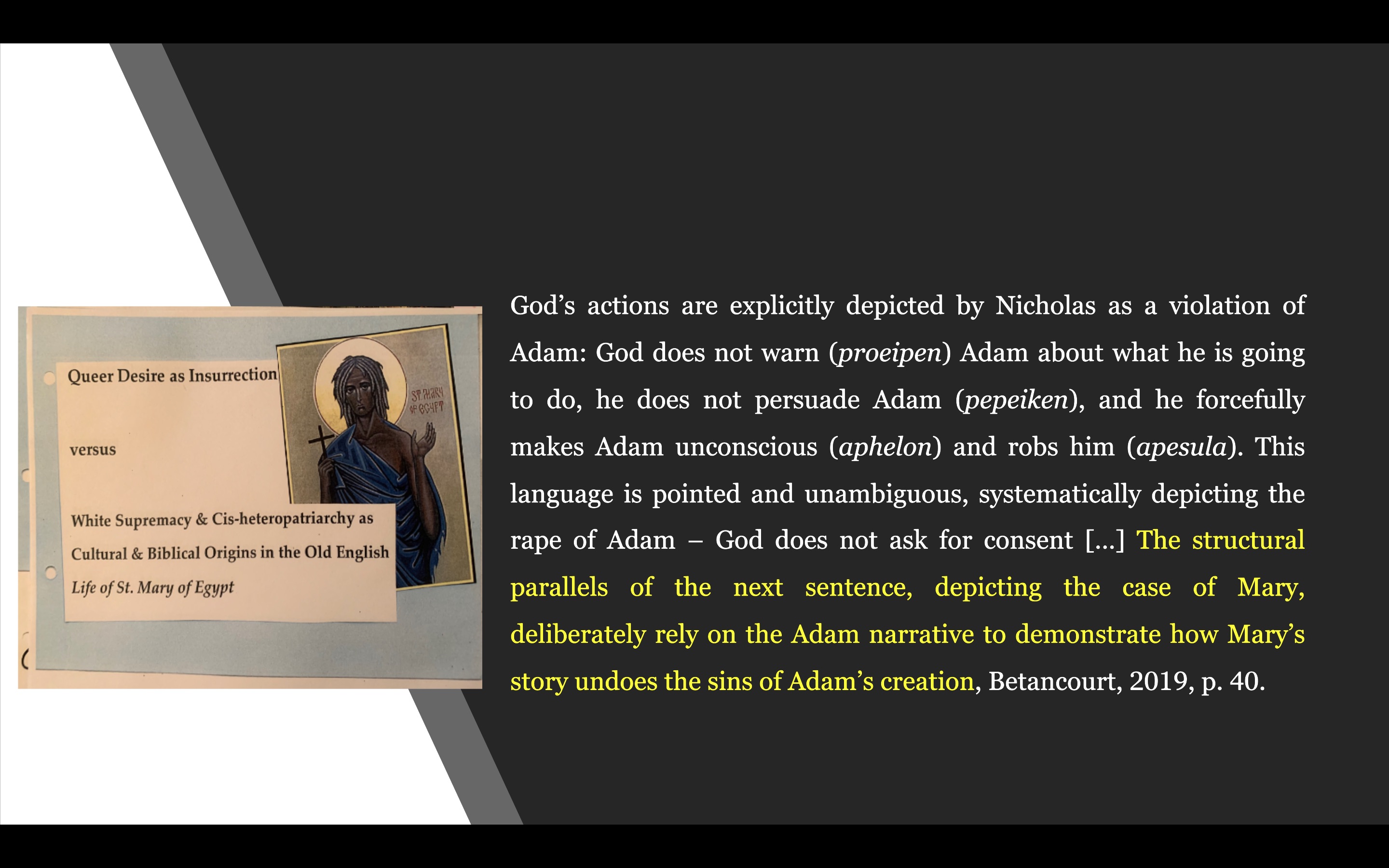
God’s actions are explicitly depicted by Nicholas as a violation of Adam: God does not warn (proeipen) Adam about what he is going to do, he does not persuade Adam (pepeiken), and he forcefully makes Adam unconscious (aphelon) and robs him (apesula). This language is pointed and unambiguous, systematically depicting the rape of Adam – God does not ask for consent […] The structural parallels of the next sentence, depicting the case of Mary, deliberately rely on the Adam narrative to demonstrate how Mary’s story undoes the sins of Adam’s creation, p. 40.
As Betancourt observes:
Nicholas thus, reworks the narratives of Eve’s adultery or rape found in gnostic and apocryphal writings, locating the misconduct and the use of force in the actions of God (p. 40).
This also explains why in later manuscript illuminations the side wound of Christ (as the second Adam) is explicitly depicted as vaginal to reflect the vulvic scar inflicted upon the body of Adam but carried by Christ as the feminized sins of humanity. This, I argue, is where masculinist conflations of God in his humanity and divinity provide the cultural archetype (and setting) for gender-based violence through the appropriation and conflation of feminized bodies and bodies of land. Thus, I argue, Adam as a biblical model of cultural subjectivity is the first [trans] depicted survivor of gender-based violence [rape], upon who in the Life, Mary, as Christlike is subsequently based.
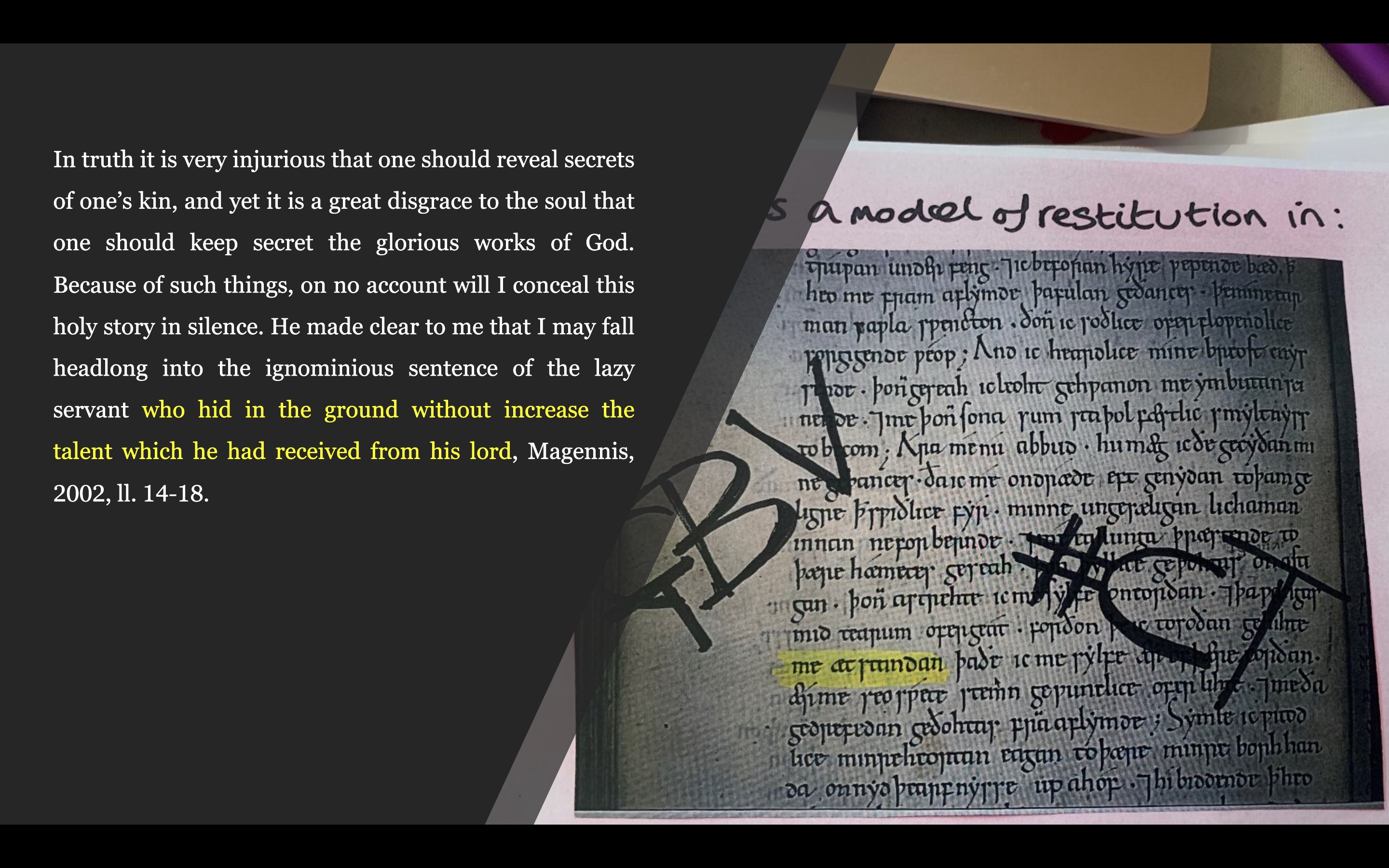
In the preface of the Life Adam is compared by unfavourable allusion to Gedeon:
In truth it is very injurious that one should reveal secrets of one’s kin, and yet it is a great disgrace to the soul that one should keep secret the glorious works of God. Because of such things, on no account will I conceal this holy story in silence. He made clear to me that I may fall headlong into the ignominious sentence of the lazy servant who hid in the ground without increase the talent which he had received from his lord, ll. 11-22.
Gedeon is called by God to save Israel (in Judges 6-8) but at first, he hides in the earth because he is afraid and doubts that it is God who he hears. Gedeon reflects the covenant broken by Adam (embodied) with Israel which is reflected as the first Fall of man. However, once Gedeon is assured it is God who he hears and not a false prophet which is how Mary is framed in the Life, he assembles a vast troop to combat Midianite insurgents, whereupon, as John & Kathleen Court note he is advised by God in psychological warfare (2007, p. 120). Gedeon reduces his troops’ number to only three hundred and this psychological strategy instils fear in the heart and minds of the enemy who are divided from within and scatter. By valorising this covert act, the author reveals the same stratagem he deploys against Mary in the Life which is to divide and rule from within.
In the prophesy of Jeremiah which concerns the restoration of Israel and foreshadows the New Covenant, God declares [quote] ‘I will put my law in their minds and write it in their hearts’ [unquote] (J & K Court, pp. 60-61). This is exactly what the author depicts when he narrates the staged and thus enforced confessions of Mary which precipitate her spoken desire for the Virgin Mary. This final covenant and its translation into the Life are key to understanding what the author is trying to achieve by his reframing of the narrative of Mary of Egypt in which she establishes a gender queer covenant with the Virgin Mary.
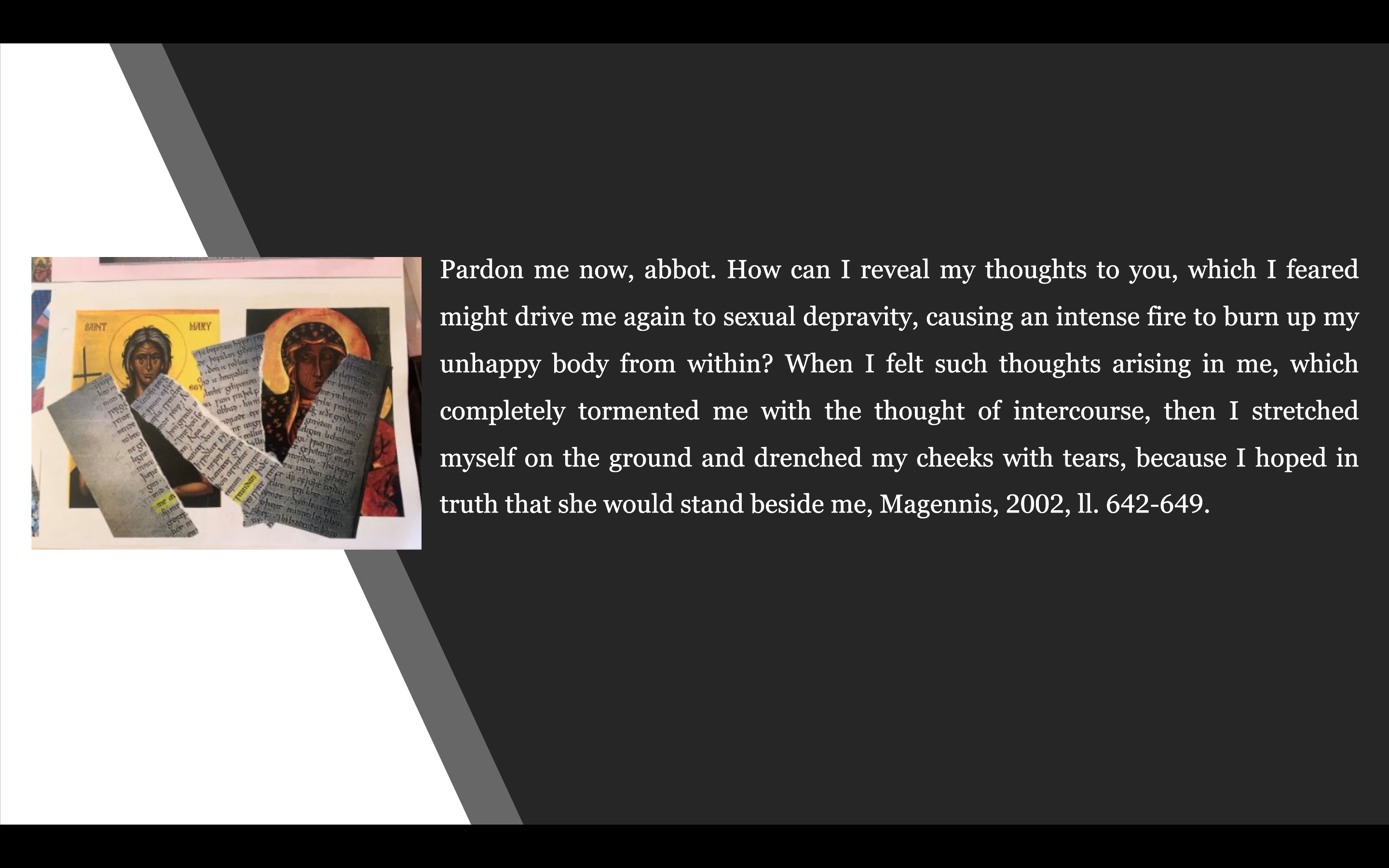
Zosimus is repeatedly depicted in coercion of Mary to confess her sexual sins:
Pardon me now, abbot. How can I reveal my thoughts to you, which I feared might drive me again to sexual depravity, causing an intense fire to burn up my unhappy body from within? When I felt such thoughts arising in me, which completely tormented me with the thought of intercourse, then I stretched myself on the ground and drenched my cheeks with tears, because I hoped in truth that she would stand beside me, ll. 642-649.
This hostile depiction of Mary is deliberately framed against the gender binary through the figure of Israel allegorized as an unfaithful land and people, but which is synthesized through the figure of Mary as both a sexually incontinent [pollutant ll. 499-500] and predatory [invasive, ll. 642-651] woman. This staged confession of Mary (personified) as Black queer desire, I argue, is a form of conversion [therapy] forcefully embodied by racialized violence inscribed upon Mary in the Life, where, to save her soul Mary must convert her queer spiritual heart and mind but also, her gender queer corporeal body.
In this paper I have illustrated the three current conceptual components of radical ecofeminism which I term: trans-authorial subjectivities, carceral thinking, and authorial coloniality, all of which I argue are visible in the Life. Authorial coloniality reflects religious and cultural attitudes of colonialism in literature which neither respect nor recognize the boundaries of lands or bodies that if they resist (invasion) are themselves considered insurgents. Carceral thinking is a psychological mode of violence exemplified by the authorial adaptations which invade Mary’s psyche in a bid to render her queerness invisible. Carceral thinking has embodied forms in textual, bodily, and environmental temporalities which accrete and function as reproductive spaces of masculinist cultural subjectivities. The third term, trans-authorial subjectivities, where queerness and transness of an author or their subject exceeds and breaks the gender binary even as they seek to uphold it in their texts, I conceived as a literary and cultural form of trans feminist mobility which I examine in a forthcoming article on Hugeburc’s Hodoeporican of St Willibald. This is embodied research, as we think not only with our minds but also our bodies, where each interdependently informs the other via the vegus nerve (Stephen Porges, 2017, 2011). Subsequently, it is not only our ways of thinking that we make visible and replicate in textual and cultural production but also our bodies and the ways of being and knowing (with) them. These ideas first took form in a recently published article: Female Masculinity in the Embodied Beowulf Wetlands: A New, Radical, Ecofeminist Approach. Together, I argue, they offer powerful models of restitution for the historical erasure of Black, queer, and trans lives.
In conclusion, I return to answer Lorde’s question: ‘What are the words you do not yet have? What do you need to say?’ Conversion by psychological or sexual violence does not work. I know this. What it does is break people in a myriad of different ways which renders them illegible to themselves and culturally invisible to others. I see this fragmentation in the structural collective violence of the adaptations made to Mary in the Life. The literary effects of confession upon Mary, who is forced to deny who she is by self-censure presented as spiritual suffering are used to teach that only certain aspects of her identity are acceptable and this, I argue, represents the lived reality of loss, absence, and trauma embodied by Mary in the Life. These adaptations are not made by just one anonymous man but by many, and women as well, as they uphold this silence which by their complicity allows these views to stand as cultural truth. As a result, they become embodied as cultural attitudes towards women and all survivors of gender-based violence that we carry within ourselves and based upon our perception of the gender binary subsequently shape our environment. Thus, I argue, Mary’s presence in the Life offers #TransJoy as a model of restitution for individual and collective intergenerational trauma as a result of gender-based violence and specifically racialized and transphobic rhetoric and sexual violence inscribed upon women’s genderqueer (nonconforming) bodies in texts.
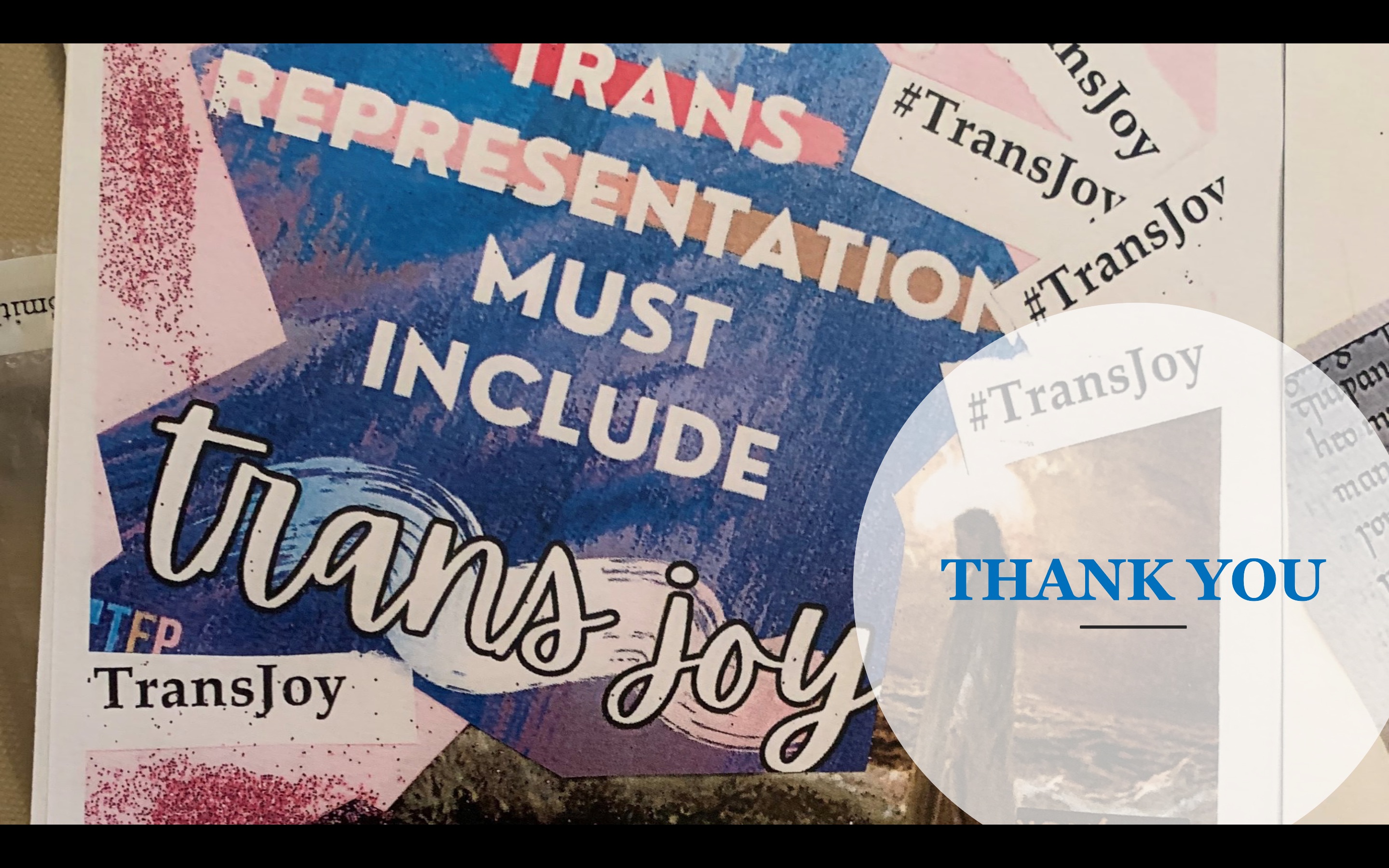
[1] Lorde, 2019, Sister Outsider, p. 30.
[2] Ibid., p. 31.
[3] Life of Cyriacus, 233, 25, trans. Price and Binns, 1991, pp. 256-258; The Spiritual Meadow of John Mochus, 179, 1. 3, trans. Wortley, 1992, pp. 148-149. See also, Hugh Magennis, 2002, pp. 3-4; Roland Betancourt, 2020, p. 1; Maria Kouli, 1996, p. 66; Benedicta Ward SLG, 1987, pp. 26-32.
[4] See, John R. Black (2008, 2017, forthcoming), for extensive scholarship of Mary of Egypt in relation to monasticism, though, ostensibly not in terms of gender upon which black does not focus.
[5] Oxford English Dictionary Online, see: Orthodoxy, n. 1. https://www.oed.com/view/Entry/132809?redirectedFrom=orthodoxy#eid (Accessed June 2022).
